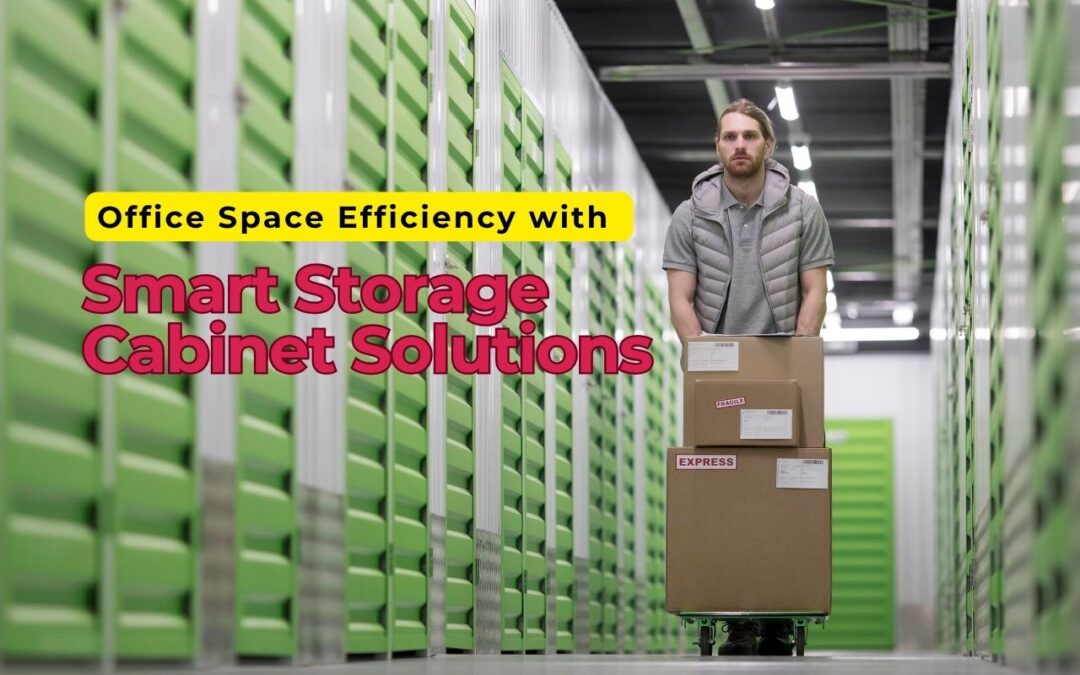The Challenge of Modern Office Space Management
In today’s dynamic business environment, office space is more than just square footage—it’s a reflection of a company’s productivity, culture, and operational efficiency. As real estate costs continue to rise, businesses of all sizes are seeking ways to make the most of every inch of their office environment. One of the most underutilized yet impactful strategies for optimizing the workspace is the implementation of smart storage cabinet solutions.
Smart storage isn’t just about organizing paper or hiding away stationery; it’s about creating systems that support workflow, reduce clutter, enhance aesthetics, and ultimately drive business efficiency. From startups in co-working spaces to multinational corporations with sprawling offices, the need to maximize space usage through intelligent storage planning has become a top priority. This blog explores how businesses can achieve better office organization and enhanced space efficiency with smart storage cabinet solutions.
Understanding the Concept of Smart Storage Cabinets
Smart storage cabinets are not merely shelves with doors—they represent a new era of functional design, where storage is integrated seamlessly with workplace operations. These solutions focus on:
- Optimizing vertical and horizontal space.
- Enhancing accessibility to stored items.
- Reducing visual clutter while maintaining design coherence.
- Supporting evolving office layouts like hot desking and hybrid work models.
Incorporating these principles helps businesses maintain a clean, professional, and productive work environment.
Why Efficient Storage Matters in Business Spaces
Before diving into solutions, it’s important to understand why efficient storage plays a vital role in overall office performance:
- Boosts Productivity: Employees waste countless hours annually searching for files, supplies, or equipment. Smart storage minimizes these time losses.
- Enhances Collaboration: Organized workspaces foster better teamwork by making shared resources more accessible.
- Improves Mental Clarity: A tidy, organized environment reduces stress and enhances focus.
- Maximizes Investment: With proper storage, businesses can make the most of their existing space without the need to expand or relocate.
Key Features of Smart Storage Cabinet Solutions
1. Modular and Flexible Designs
Modern offices evolve frequently—teams grow, departments shift, and remote work impacts in-office demands. Smart storage units can be modular, meaning they can be reconfigured, stacked, or relocated easily to suit changing needs.
2. Vertical Utilization
Many traditional office setups fail to make use of vertical space. Smart cabinets maximize height with floor-to-ceiling options, keeping essential items accessible while utilizing underused areas effectively.
3. Concealed Compartments
For offices aiming to maintain a minimalist aesthetic, storage solutions with hidden compartments allow for efficient organization without visual clutter. These units preserve the clean lines of modern design while storing more than they appear to.
4. Secure Sections for Sensitive Items
Smart cabinet systems often integrate features that allow restricted access for storing sensitive documents or expensive equipment, making security seamless and unobtrusive.
5. Integrated Functionality
Some storage cabinets serve multiple purposes—like doubling as room dividers, desks, or even collaborative whiteboard surfaces—helping to reduce the furniture footprint in busy workspaces.
Smart Storage Strategies for Different Office Areas
Reception and Waiting Areas
These spaces often go overlooked but can be enhanced with cleverly designed cabinets that store marketing materials, visitor supplies, or even tech accessories, keeping the area clean and welcoming.
Executive Offices
High-level offices require both style and functionality. Smart storage in these rooms often emphasizes hidden compartments, sleek finishes, and room for personal items, helping executives maintain an uncluttered professional space.
Meeting Rooms
Conference rooms benefit from cabinets that store cords, adapters, notepads, and other meeting essentials. Concealed solutions ensure the room is always ready for impromptu gatherings.
Open Workspaces
In shared office spaces, smart storage becomes even more essential. Lockable drawers, under-desk units, and shared modular shelving systems help maintain individual organization in communal areas.
Break Rooms and Cafeterias
Cabinets in these areas help store kitchenware, coffee supplies, and cleaning products efficiently. Solutions with labeled or categorized compartments improve usability and hygiene.
Supply Closets and Archive Rooms
Spaces dedicated to long-term or bulk storage can still benefit from smart cabinet designs that make retrieval faster and inventory easier to track.
Benefits of Implementing Smart Cabinet Solutions in Your Office
1. Reduced Clutter, Increased Focus
A disorganized office can impact employee concentration and morale. Smart storage ensures that every item has a designated place, creating a visually calming and productive environment.
2. Efficient Use of Limited Space
Urban offices often have limited real estate. Smart cabinets help businesses do more with less by exploiting overlooked nooks, corners, and vertical zones.
3. Streamlined Operations
From document filing to storing frequently used tools, optimized storage leads to faster operations and less downtime.
4. Professional Appearance
Cluttered offices leave a poor impression on clients, partners, and employees. Clean lines and purposeful layouts showcase a company’s commitment to quality.
5. Future-Proofing the Workspace
As businesses adopt hybrid and remote work models, smart storage makes it easier to adapt layouts without extensive renovations.
Tips to Choose the Right Storage Cabinet System
- Assess Current and Future Needs: Before purchasing or designing a system, evaluate what your team currently uses and anticipate how storage needs might change.
- Maximize Accessibility: Ensure that important items are within easy reach while less-used materials are stored out of the way.
- Promote Shared Responsibility: Encourage employees to maintain the organization by involving them in the planning process or creating clear cabinet guidelines.
- Prioritize Multi-Functionality: Opt for designs that serve dual purposes to minimize unnecessary furniture.
- Choose Aesthetic Coherence: Storage solutions should blend with the overall office decor for a unified look.
Implementing Smart Storage: Practical Considerations
While the theory sounds great, execution is where many businesses struggle. Here are a few practical ways to roll out smart storage strategies:
- Start with a Storage Audit: Identify areas of clutter and disorganization and evaluate what needs to be stored more efficiently.
- Create Zones: Divide the office into logical zones (administration, tech, meeting, etc.) and implement tailored storage systems for each.
- Label Everything Clearly: Whether physical or digital, labeling helps avoid confusion and ensures everyone knows where items belong.
- Get Employee Feedback: Staff know best what they use and how they work. Involving them in the planning stage ensures the final system serves real needs.
- Maintain the System: Even the best storage solution fails without proper maintenance. Appoint a team or schedule regular clean-up reviews.
The ROI of Smart Storage
Investing in storage doesn’t always seem glamorous, but the return is tangible. Companies report:
- Faster onboarding and smoother workflow.
- Decreased employee frustration and miscommunication.
- Lower expenses due to fewer misplaced items and redundant purchases.
- Improved client perception from neater, more professional spaces.
In essence, smart storage pays for itself by making every part of the office operate more smoothly and effectively.
Conclusion: A Smarter Office Starts with Smarter Storage
As the modern office evolves, one truth remains: organized environments create better business outcomes. Smart storage cabinet solutions are more than just functional additions—they’re essential tools for maximizing space, improving productivity, and adapting to changing work models.
Whether you’re managing a compact startup space or a sprawling corporate floor, taking the time to assess, plan, and implement efficient storage systems can have a profound impact on your company’s performance. Remember, every inch counts—and how you use that inch can make all the difference.
FAQs:
Q1. What are smart storage cabinet solutions in an office setting?
Smart storage cabinets are designed to maximize space, reduce clutter, and support flexible office operations through efficient and often multi-functional storage options.
Q2. How do smart storage cabinets improve office productivity?
By organizing office materials and making them easily accessible, these solutions reduce wasted time and allow employees to focus more on their work.
Q3. Can smart storage be used in small offices or home offices?
Absolutely. Smart storage is especially beneficial in small or home office setups where space is limited and must be used creatively.
Q4. How often should office storage systems be reviewed or updated?
It’s good practice to audit storage needs at least once a year or whenever there’s a significant change in staff size, work structure, or office layout.
Q5. What’s the biggest mistake companies make with office storage?
One common mistake is underestimating the importance of accessibility and aesthetics. Storage should not only be practical but also contribute positively to the office environment.












